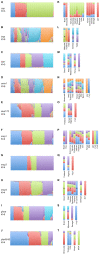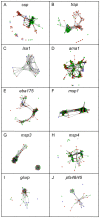Contrasting population structures of the genes encoding ten leading vaccine-candidate antigens of the human malaria parasite, Plasmodium falciparum
- PMID: 20041125
- PMCID: PMC2795866
- DOI: 10.1371/journal.pone.0008497
Contrasting population structures of the genes encoding ten leading vaccine-candidate antigens of the human malaria parasite, Plasmodium falciparum
Abstract
The extensive diversity of Plasmodium falciparum antigens is a major obstacle to a broadly effective malaria vaccine but population genetics has rarely been used to guide vaccine design. We have completed a meta-population genetic analysis of the genes encoding ten leading P. falciparum vaccine antigens, including the pre-erythrocytic antigens csp, trap, lsa1 and glurp; the merozoite antigens eba175, ama1, msp's 1, 3 and 4, and the gametocyte antigen pfs48/45. A total of 4553 antigen sequences were assembled from published data and we estimated the range and distribution of diversity worldwide using traditional population genetics, Bayesian clustering and network analysis. Although a large number of distinct haplotypes were identified for each antigen, they were organized into a limited number of discrete subgroups. While the non-merozoite antigens showed geographically variable levels of diversity and geographic restriction of specific subgroups, the merozoite antigens had high levels of diversity globally, and a worldwide distribution of each subgroup. This shows that the diversity of the non-merozoite antigens is organized by physical or other location-specific barriers to gene flow and that of merozoite antigens by features intrinsic to all populations, one important possibility being the immune response of the human host. We also show that current malaria vaccine formulations are based upon low prevalence haplotypes from a single subgroup and thus may represent only a small proportion of the global parasite population. This study demonstrates significant contrasts in the population structure of P. falciparum vaccine candidates that are consistent with the merozoite antigens being under stronger balancing selection than non-merozoite antigens and suggesting that unique approaches to vaccine design will be required. The results of this study also provide a realistic framework for the diversity of these antigens to be incorporated into the design of next-generation malaria vaccines.
Conflict of interest statement
Figures



Similar articles
-
Global diversity of the gene encoding the Pfs25 protein-a Plasmodium falciparum transmission-blocking vaccine candidate.Parasit Vectors. 2021 Nov 8;14(1):571. doi: 10.1186/s13071-021-05078-6. Parasit Vectors. 2021. PMID: 34749796 Free PMC article.
-
Within-population genetic diversity of Plasmodium falciparum vaccine candidate antigens reveals geographic distance from a Central sub-Saharan African origin.Vaccine. 2013 Feb 18;31(9):1334-9. doi: 10.1016/j.vaccine.2012.12.039. Epub 2013 Jan 4. Vaccine. 2013. PMID: 23295064
-
Analysis of genetic diversity and population structure of gene encoding cell-traversal protein for ookinetes and sporozoites (CelTOS) vaccine candidate antigen in global Plasmodium falciparum populations.Infect Genet Evol. 2018 Apr;59:113-125. doi: 10.1016/j.meegid.2018.01.023. Epub 2018 Jan 31. Infect Genet Evol. 2018. PMID: 29391203
-
Genetic polymorphism in Plasmodium falciparum vaccine candidate antigens.Indian J Pathol Microbiol. 2005 Oct;48(4):429-38. Indian J Pathol Microbiol. 2005. PMID: 16366089 Review.
-
Towards an RTS,S-based, multi-stage, multi-antigen vaccine against falciparum malaria: progress at the Walter Reed Army Institute of Research.Vaccine. 2005 Mar 18;23(17-18):2243-50. doi: 10.1016/j.vaccine.2005.01.142. Vaccine. 2005. PMID: 15755604 Review.
Cited by
-
Defining the antigenic diversity of Plasmodium falciparum apical membrane antigen 1 and the requirements for a multi-allele vaccine against malaria.PLoS One. 2012;7(12):e51023. doi: 10.1371/journal.pone.0051023. Epub 2012 Dec 5. PLoS One. 2012. PMID: 23227229 Free PMC article.
-
Diversity of T cell epitopes in Plasmodium falciparum circumsporozoite protein likely due to protein-protein interactions.PLoS One. 2013 May 7;8(5):e62427. doi: 10.1371/journal.pone.0062427. Print 2013. PLoS One. 2013. PMID: 23667476 Free PMC article.
-
Host-mediated selection impacts the diversity of Plasmodium falciparum antigens within infections.Nat Commun. 2018 Apr 11;9(1):1381. doi: 10.1038/s41467-018-03807-7. Nat Commun. 2018. PMID: 29643376 Free PMC article.
-
Infectivity of Chronic Malaria Infections and Its Consequences for Control and Elimination.Clin Infect Dis. 2018 Jul 2;67(2):295-302. doi: 10.1093/cid/ciy055. Clin Infect Dis. 2018. PMID: 29757358 Free PMC article.
-
Worldwide genetic variability of the Duffy binding protein: insights into Plasmodium vivax vaccine development.PLoS One. 2011;6(8):e22944. doi: 10.1371/journal.pone.0022944. Epub 2011 Aug 2. PLoS One. 2011. PMID: 21829672 Free PMC article.
References
-
- Moran M, Guzman J, Ropars A, Jorgensen M, McDonald A, et al. The Malaria Product Pipeline: Planning for the future. Sydney: The George Institute for International Health; 2007.
-
- World Health Organization. Malaria Vaccine Rainbow Table. 2008
-
- Mu J, Awadalla P, Duan J, McGee KM, Keebler J, et al. Genome-wide variation and identification of vaccine targets in the Plasmodium falciparum genome. Nat Genet. 2007;39:126–130. - PubMed
Publication types
MeSH terms
Substances
Grants and funding
LinkOut - more resources
Full Text Sources
Other Literature Sources
Research Materials

